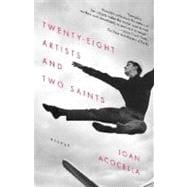
What is included with this book?
| List of Illustrations | p. xi |
| Introduction | p. xiii |
| A Fire in the Brain | p. 3 |
| Blocked | p. 17 |
| True Confessions | p. 35 |
| Quicksand | p. 51 |
| The Frog and the Crocodile | p. 63 |
| Becoming the Emperor | p. 81 |
| A Hard Case | p. 99 |
| European Dreams | p. 115 |
| The Neapolitan Finger | p. 133 |
| The Saintly Sinner | p. 149 |
| After the Ball Was Over | p. 169 |
| Heroes and Hero Worship | p. 193 |
| "Sweet as a Fig" | p. 215 |
| American Dancer | p. 229 |
| Second Act | p. 239 |
| The Soloist | p. 265 |
| The Flame | p. 291 |
| Dancing and the Dark | p. 319 |
| The Bottom Line | p. 333 |
| On the Contrary | p. 347 |
| After the Laughs | p. 357 |
| Feasting on Life | p. 371 |
| Finding Augie March | p. 381 |
| Piecework | p. 395 |
| The Spider's Web | p. 407 |
| Assassination on a Small Scale | p. 419 |
| The Hunger Artist | p. 437 |
| Counterlives | p. 459 |
| Perfectly Frank | p. 471 |
| Devil's Work | p. 495 |
| Burned Again | p. 507 |
| Acknowledgments | p. 521 |
| Textual Permissions | p. 523 |
| Index | p. 525 |
| Table of Contents provided by Ingram. All Rights Reserved. |
The New copy of this book will include any supplemental materials advertised. Please check the title of the book to determine if it should include any access cards, study guides, lab manuals, CDs, etc.
The Used, Rental and eBook copies of this book are not guaranteed to include any supplemental materials. Typically, only the book itself is included. This is true even if the title states it includes any access cards, study guides, lab manuals, CDs, etc.
Excerpted from Twenty-Eight Artists and Two Saints: Essays by Joan Acocella
All rights reserved by the original copyright owners. Excerpts are provided for display purposes only and may not be reproduced, reprinted or distributed without the written permission of the publisher.